PinotFile: 6.21 April 1, 2007
|
On a High at Pinot Paradise WeekendSanta Cruz has been in the news of late. The city is fighting with the city of Huntington Beach in Southern California over the use of the name, “Surf City,” and the Santa Cruz Beach Boardwalk is celebrating its 100th anniversary. The boardwalk was once promoted as the “Coney Island of the West,” and is now the last of its kind on the West Coast. It is a throwback to simpler times, when ferris wheels, wooden roller coasters, and cotton candy were part of everyone’s childhood memories. The boardwalk is still going strong and this year there will be fireworks, concerts, and appearances by the Moscow Circus to commemorate the anniversary. 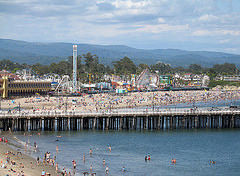
The history of winegrowing in the Santa Cruz Mountains goes back to at least the 1860s when George Jarvis planted vines in the Vine Hill area of Santa Cruz County. By the late 1880s, there were thirty-eight, mostly small wineries. The largest winery was the Ben Lomond Wine Co., on Highway 9, north of Felton, which made 40,000 gallons annually. There were 1,600 planted acres by 1905, with vineyards concentrated in the Felton, Bonny Doon, Vine Hill, Ben Lomond and Boulder Creek areas on the western side of the Santa Cruz Mountains. Phylloxera did not easily find its way into the mountains and most of the vines were healthy into the 1930s. After Repeal, the Italians opened several small wineries and one, Bargetto, is still in production and is Santa Cruz’s oldest.  
There are a number of lesser-known, but important, winegrowing pioneers in the Santa Cruz Mountains. Their story is told in detail in several books including: Like Modern Edens:Winegrowing in Santa Clara Valley and Santa Cruz Mountains, 1798-1981, written by Charles Sullivan and published in 1982, A Companion to California Wine, also authored by Charles Sullivan (1998), and more recently, Mountain Vines, Mountain Wines: Exploring the Wineries of the Santa Cruz Mountains, written by Casey Young and Ken Dawes (2003). The Santa Cruz Mountains Viticultural Appellation was federally approved in 1981 and was one of the first American viticultural areas to be defined by geophysical, altitudinal, and climatic factors. The appellation includes the Santa Cruz Mountain range from Half Moon Bay in the north to Mount Madonna north of Gilroy in the south. The east and west boundaries are defined by elevation, including mountainous land above 400 feet on the western side, and from 400 to 800 feet on the eastern side. The squiggly outline of the AVA reflects the fog line that surrounds the mountains. 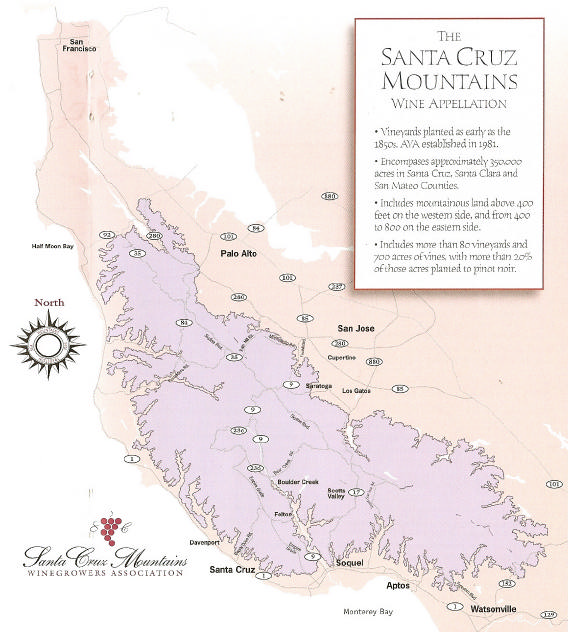
The quality of the Pinot Noir grapes grown in the Santa Cruz Mountains appellation is unquestioned, but the challenges in growing wine in this mountainous terrain with its harsh climate are numerous. The vineyard sites are often rugged and remote, irrigation water is very limited or nonexistent, pests such as birds (all vineyards must be netted), deer, and gophers are ever-present, skilled labor is hard to find, top soil is poor in many sites, and yields are typically less than two tons-per-acre. Randall Grahm began his career in the wine business in the early 1980s, hoping to make a great California Pinot Noir in the Santa Cruz Mountains. His 1975 Pinot Noir was so promising, he started a winery in the region called Bonny Doon. He soon realized, however, that he could make better Pinot Noir from Oregon grapes, and by 1985, had budded over his entire vineyard to Rhone varietals (most recently, however, Grahm plans to begin crafting Pinot Noir once 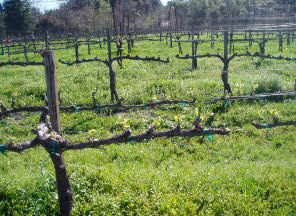
The 7.1 Loma Prieta earthquake in October, 1982, was a blow to the wine industry in the mountains. Many wineries were destroyed, but a number of producers rebuilt and persisted, including Jerold O’Brien of Silver Mountain (whose vineyard at recent bud break in mid-March is pictured), and Dave and Anne Moulton of Burrell School. A number of well-heeled Silicon Valley entrepreneurs have found the mountains appealing leading to a noticeable increase in planted acreage in the last several years. T.J. Rodgers (Cypress Semiconductor) at Clos de la Tech (see feature later in this issue) and Ed Muns (former HP executive), with Muns Vineyard (also featured), among others, have persisted. However, faced with the hardships and realities of farming grapes here, several less-hardy opportunists have abandoned their plans. It is the small and determined family producers whose wines often best exemplify the unique terroir and pinosity of the region. A number of very experienced vineyard consultants including Prudy Foxx and Greg Stokes, are actively assisting growers in choosing appropriate sites, and offering planting and management expertise. As recently as 2003, there were 54 wineries, both bonded and virtual, today there are about 90 wineries.
Like many cooler growing areas that attract Pinot Noir growers, the Santa Cruz Mountains is a marriage of fog and sun. The grapes ripen in cool temperatures as the daily fog rolls in sometime in the late afternoon or early evening, with the sun burning the fog off the next morning. The growing season is extended, creating grapes with complex and intense flavors and lively acidity. There are four main growing areas from north to south: Portola Valley, Bonny Doon, Summit, and Corralitos The Pinot Noirs from the Santa Cruz Mountains have lovely aromatics, luscious red and dark fruit flavors, soft tannins, and are usually packaged in a light- to medium-bodied sensual wine so juicy you can ‘nibble’ at it. In the 1980s, Santa Cruz Mountains Pinot Noirs had a reputation for being rustic, chunky, and tannic. This was based on wines from Thomas Fogerty and Santa Cruz Mountain Vineyards, among others, who were using markedly different winemaking techniques compared to those employed now. Today, the Pinot Noirs are very modern in style with incredible value-to-price ratios. My recent visit to the Santa Cruz Mountains for the Pinot Paradise event reinforced my belief that these wines deserve every pinotphile’s serious interest. “It’s a hard grape to grow … it’s thin-skinned, temperamental, ripens early … It’s not a survivor like Cabernet, which can just grow anywhere and thrive even when it’s neglected. No, Pinot needs constant care and attention… .it can only grow in these really specific, little, tucked-away corners of the world. And only the most patient and nurturing of growers can do it, really. Only somebody who really takes the time to understand Pinot’s potential can then coax it into its fullest expression.” ... ‘Sideways’ 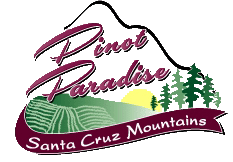 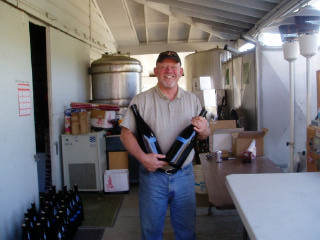 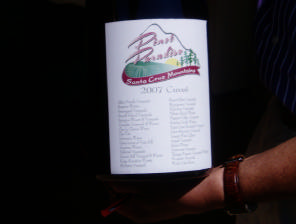
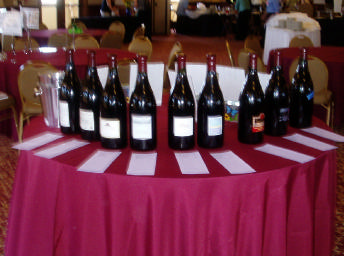
John Haeger is the distinguished author of North American Pinot Noir and a former wine writer and columnist for numerous wine publications. Currently he is updating his book, first published in 2004, to include profiles and tasting notes on many Pinot Noir producers in addition to the 70 included in the first issue. Haeger brings a scholarly approach to the history of Pinot Noir in North America. Some excerpts from his talk are presented below. Worldwide, there are about 213,000 acres of Pinot Noir, 40,000 of which are in America. Pinot Noir accounts for 2% of worldwide grape vineyard acreage, and about 1.1% of worldwide wine production. In California, recent figures show 70,000+ tons of Pinot Noir were crushed, about 2% of the total grape crush. In Oregon there was less total grape tonnage crushed, 17.000+, but 50% of the total was Pinot Noir. The most widely planted grape variety in the world is Airen, a Spanish grape used in brandy! Pinot Noir originated from a single alpha vine somewhere in northeast France or Germany. The exact date of appearance is unclear, but certainly postdated the Romans. The name appears for the first time in the 14th century. Through the years there have been many paranyms for Pinot Noir in California: Frank Pinot, Noirien, Pinot de Pernand, Pinot de Coulanges, Pinot from Champagne, Cote d’Or Grape, Red Pinot, Pinot St. George, and Black Burgundy. The first person to import Pinot Noir to the United States from Europe could have been any of several candidates: Pierre Pellier, Agoston Haraszthy, or Charles LeFranc. The grape was in California by 1850. The largest pre-prohibition planting of Pinot Noir was at Fountaingrove Vineyard, north of Santa Rosa in the 1930s. Fountaingrove’s 1935 vintage was actually labeled Sonoma Pinot Noir. In 1889, the University of California established an experimental five-acre grape vineyard near the town of Jackson in the Sierra Foothills of California. Professor Eugene Hilgard was the head of this project. The Jackson station was closed in 1903 as it was determined not to be an ideal location for viticulture. Because of its isolated location, the vineyard survived phylloxera, and when rediscovered in 1963, the surviving vines were disease-free and cuttings were sent to the university’s vineyard at Davis. These cuttings became known as the Jackson clone (UCD 8 and 16) and they have the distinction of being the earliest documented imports of Pinot Noir still cultivated in North America. The block of Pinot Noir planted at Hanzell in Sonoma in 1952 is the oldest continuously cultivated Pinot Noir vines in the United States. 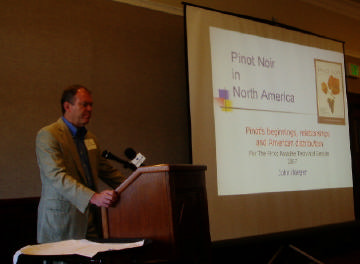 Jerome Aubin is a Frenchman who grew up in Burgundy, near Beaune, in a region of forests known for producing French oak barrels. He came to the United States in 1994 to represent Tonnelerie Rousseau headquartered in Burgundy, France. Recently, he began producing his own California Pinot Noir from the Sonoma Coast and Russian River Valley under the Verve label. Aubin presented a very enlightening discussion on the importance of barrels in the Pinot Noir aging process. The use of oak in winemaking dates back 2000 years. The Celts introduced the barrel as a wine vessel to the Romans who had used fragile amphoras. Originally, oak was used as a flavor addition, along with herbs, to improve the taste of crudely made wines of the time. The oak barrel’s purpose, aside from being a vessel, is to age wine and add a subtle oak flavor. Oak integration is a key word to describe a harmonious marriage between the fruit and the oak. Additionally, the barrel’s shape enables the sedimentation of wine to occur naturally. Most barrels used for California’s premium wines are French. Eastern European oak, which is the same species as French oak, has become more popular. but the Eastern European forests have not been as well managed as those in France. Aubin is now importing Hungarian cooperage, prized for its tight grain, reduced tannin, and interesting flavor profile. American oak is not an option for Pinot Noir, in part because of high lactone levels. After the oak is harvested, it is cut to rough stave size and split mechanically or manually with axes following the grain of the wood. The staves are stacked and open-air dried for a minimum of two years. This aging in wind, rain and sun serves to diminish the wood’s harsh, sappy flavors as well as reducing the excessive oak tannins. An increasing number of premium winemakers are choosing to extend barrel seasoning to 36 months to guarantee the elimination of green tannins and phenols. The aged staves are sorted and the edges are jointed in order to form a circle when bent and assembled. The staves are temporarily circled at one end to form an open cone shape. The is called “raising the barrel.” The shell is heated over an open fire, causing water in the wood to steam, which allows the staves to be bent without cracking. This takes about 20 minutes. Afterward, a cable and winch are used to close the other end which is then bound. This is known as the first fire-bending. The second firing, also about 20 minutes, conditions the barrel and relieves stress. The interior becomes drier and hard where it is closed to the fire, while the outside softens and stretches as it warms. There are three important decisions the winemaker must make with regard to his cooperage of choice.
(2) Seasoning. This refers to the amount of time the oak is left outside to air-dry in the elements. The average period is 18-24 months. Oak with 24 months of seasoning is best for programs where the Pinot Noir is aged 10-12 months (about average for California). Oak seasoned for 36 months is best when longer aging is planned. (3) Toasting. The regimen for toasting varies considerably among different coopers. Each cooper has his own recipe to best toast and “cook” a barrel. Barrels fashioned from the same tree, fired to the same toast level, but made by two different coopers may have totally different flavors. Winemakers have the opportunity to choose the cooper and toast level that best suits their wine. Without toasting, the barrel imparts green and astringent tannins. Toasting tones down phenolic compounds, adds flavors, and contributes texture, weight, and aromatics to the finished wine. One can choose from light, medium or heavy toast levels, each of which has a significant flavor profile ranging from slightly toasty (grilled bread) to caramelized (butterscotch) to smoky (bacon) A heavily toasted barrel can even be brought to the burnt point (char). Over the last five to eight years, most winemakers prefer more gentle toasting in the light to moderate range. (According to Wines & Vines, July 2005, the flavor compounds from oak released by toasting are vanillin, guaiacol - char-like smoky aroma, eugenol - a clove-like smell, furfural - sweet butterscotch and caramel aromas, ellagitannins - astringent taste reduced at heavy toast levels, and lactones - smell of coconut, but in wine smell oaky as well.) Other factors go into the choice of barrel including stave thickness, size , and shape of barrel. The Burgundian barrel is short and fat in comparison to the Bordeaux barrel which is taller and narrower. There is increasing interest in the use of larger oak vessels for both fermentation and aging. A wood fermenting vessel allows for a gentle fermentation curve, extended fermentation, better retention of heat, and less required intervention. There are some complex chemical advantages as well which I won’t go into. Many more different sizes of oak cask are now offered, with some producers believing that larger containers such as a 450- or 500-liter puncheon or a 300-liter hogshead suit certain types of wine better than the standard 225-liter barrique. The demand for oak barrels is markedly less than it used to be. In the late 1980s and much of the 1990s, the world’s winemakers seemed convinced that the shortcut to wine quality was to invest in small barrels which would magically confer sophistication and texture on even substandard fruit. Today things are different with winemakers in France using on average 20% new oak, and in California 40% new oak. Wine drinkers want fruit and even sometimes unadorned fruit. Many wine producers are re-using barrels for up to six or more vintages rather than buying new barrels every year, sometimes replacing the odd stave with a new one. Others are turning to other ways to give oak treatment without the expense of buying barrels. Examples are “planks in tanks,” oak staves or planks suspended in stainless steel tanks. Even cheaper are ways of mingling wine with small fragments of oak, whether small chips in porous bags in a tank, or increasingly popular, shavings. These are offered with every possible nuance that a top quality barrel can offer: a range of toast, and Vosges, Allier or Nevers forest origin. An alternative technique has been widely adopted to make younger, cheaper reds more palatable. Micro-oxygenation (“Microx”) involves bubbling tiny amounts of oxygen through the wine which, in a very crude way, mimics the sort of reactions with oxygen encouraged by barrel aging. It rarely benefits very fine wine, but it can rush coarse, tough young reds on to the marketplace by softening all of their rough edges. Still another technique popularized by Chris Ringland, the Kiwi behind one of Australia’s first cult wines, Three Rivers, is called “Macrox.” This involves deliberately exposing the fermenting must, particularly of deep-flavored, intensely rich red wines, to as much air as possible while they are made. By fermenting them in vats with wide, open tops and deliberately aerating them often so as to soften the tannins, the texture becomes more velvety and the risk of any subsequent reduction and its accompanying sulfide stink are minimized.
I really enjoyed this event. The winemakers were eager to show off their latest Pinot Noirs and their were fans of every winery in attendance. These walk-around tastings offer only a brief glimpse of the wines, but stellar wines can leave a lasting impression. All of the Pinot Noirs poured at this event were made from grapes from the Santa Cruz Mountains. I was able to taste every producer’s wines at the event and here are my favorites. Burrell School Vineyards & Winery Located at a historic red schoolhouse dating to 1854 on Summit Road, Dave and Anne Moulton grow and produce premium estate wines. 2005 Burrell School Santa Cruz Mountains Estate Pinot Noir (barrel sample). The Pinot Noir from the estate vineyard seems to get better every year and this one is a blockbuster. Note the matching hats and shirts on the Burrell School pour gang. Www.burrellschool.com.  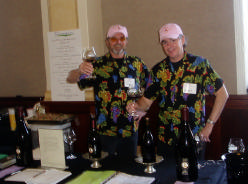
Clos La Chance Winery A family-owned winery specializing in handcrafted wines from estate vineyards (150 acres in San Martin) and the Santa Cruz Mountains. Owners Bill and Brenda Murphy established CK Vines, a vineyard maintenance and installation company, specializing in “back-yard” vineyard development in the Santa Cruz Mountains appellation. The rugged topography and costs associated with planting in the mountains limits the size and number of vineyards. With CK Vines supplying financial and management support, the Murphys are assured of a continuing supply of high-quality fruit. Two wines poured were outstanding: 2004 Clos La Chance Santa Cruz Mountains Pinot Noir 14.5% alc.,2334 cases, $30, and 2004 Clos La Chance Biagini Santa Cruz Mountains Pinot Noir 14.2% alc., 280 cases, $40. The Santa Cruz Mountains blend is ready to drink now, while the Biagini is a heftier and more complex release that could be cellared awhile. Highly recommended. Www.closlachance.com  Clos Tita Winery David and Britta Estrada have a one-acre estate vineyard (700 vines) planted in 1990 at 900 feet in the Scott’s Valley region of the Santa Cruz Mountains. The vineyard is worked entirely by hand, and every vine is pruned by David, who is also the winemaker and cellar master. As a practicing dentist, from September to December he has purple fingers under his gloves in the office. The wines show a unique and personalized expression of the mountain terroir. The vines are short, closely spaced, and dry farmed. Production is tiny, 75-150 cases of Estate Pinot Noir and a couple hundred cases of a Pinot Noir Cuvee from purchased Santa Cruz Mountain grapes. The Estate Pinot Noir is aged for two years in 75% new French oak. I had the opportunity to taste both of the latest releases at the Pinot Cruz tasting and also at my home. Wines are sold at the winery. Www.clos-tita.com, 831-439-9235.
2004 Clos Tita Santa Cruz Mountains Cuvee Pinot Noir 14.5% alc.. · Aromas and flavors of warm cherry cobbler, cranberry and cassis. The mouth feel is soft and gentle and the wine goes down easy, ending in dusty oak tannins.
2004 Clos Tita Estate Santa Cruz Mountains Pinot Noir 15.6% alc., $37. A touch of Chardonnay and Viognier from the estate vineyard is included in this wine. · This is a vin de guard wine for the mountains. Complex and rich aromas of cherries, soy and some savage lead to a deep dark cherry and cassis palate with appealing pepper flavors and earthy overtones. Even at this high alcohol, there is enough fruit and tannin for balance. Needs an essay.
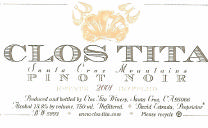 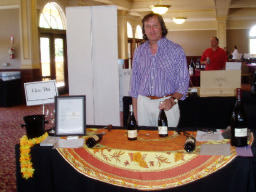
Domenico Wines This newer winery with an Italian sole has a tasting room and event venue on the San Francisco Peninsula in San Carlos (1697 Industrial Road). Since beginning 18 months ago, the winery has won 69 medals in competitions! The winemaker is Dominick Chirichillo. A wide range of wines are produced from the Santa Cruz Mountains and purchased grapes from other appellations in California, primarily Amador County, including whites (Malvasia Blanca, Pinot Grigio, Sauvignon Blanc, Viognier, and Chardonnay) and reds (Pinot Noir, Nebbiolo, Aglianico, Barbera, Sangiovese, Zinfandel, Cabernet Franc, Pinotage, Merlot, Cabernet, Meritage, and Syrah). The winery also operates The Bacchus Winemaking Club where wine enthusiasts can make quality wine at the facility under the direction of Chirichillo. Www.domenicowines.com. Www.bacchuswinemakingclub.com.
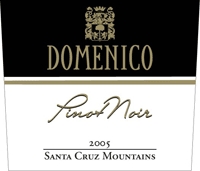 2005 Domenico Deer Park Ranch Vineyard Santa Cruz Mountains Pinot Noir $35. This wine has won multiple medals in competitions including a Gold Medal at the Grand Harvest Awards. · A big, plush style for fruit freaks, but under control and very satisfying
Hallcrest Vineyards Hallcrest is the most award winning winery in the Santa Cruz Mountains. John Schumacher and family purchased the site in Felton in1987. It had been operating as Felton Empire Winery and they restored the historical name of the property to Hallcrest. John is crafting some really exciting Pinot Noirs. The quaint tasting room at Hallcrest is an ideal spot to sip Pinot. Www.hallcrestvineyards.com.
2004 Hallcrest Santa Cruz Mountains Barrel Select Pinot Noir 437 cases, $35. · A strikingly good wine with a bold style, but a very sexy, velvety mouth feel.
2004 Hallcrest Terra Serena Vineyard Santa Cruz Mountains Pinot Noir 166 cases, $35 From one of the oldest and one of the few dry farmed Pinot Noir vineyards in the Santa Cruz Mountains. · Very floral and more elegant in fashion, this is one fine Pinot.
2003 Hallcrest Belle Farms Santa Cruz County Pinot Noir 91 cases, $35. This Pinot is from a 1 and 1/2 acre vineyard in the Watsonville foothills. · It shouts strawberries and spice and everything nice. Thoroughly satisfying.
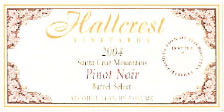 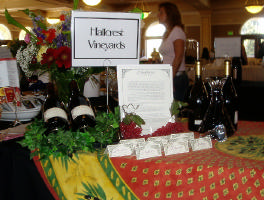 Hunter Hill Vineyard & Winery This is a newer family owned boutique winery in the hills of Soquel in the Santa Cruz Mountains appellation. The property was the old Manildi farm, where apples and stone fruits as well as grapes were grown back at the turn of the century. In 1992, Christine and Vann Slatter replaced the old apple trees on one sunny hillside with Merlot grapes. Vann started making wine in his basement and encouraged by the results, expanded the 6-acre estate vineyard to include Pinot Noir and Syrah. A tasting room on the property is open weekends.
2005 Hunter Hill Santa Cruz Mountains Pinot Noir Young Vines A very palate-pleasing Pinot Noir. Fruity with great spice and vim.
 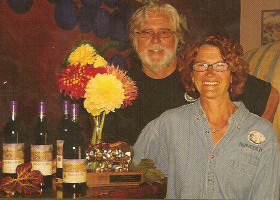 There also is a 2004 Hunter Hill Hellenthal Vineyard Sonoma Coast Pinot Noir ($25) that has been highly awarded. Www.hunterhillwines.com. 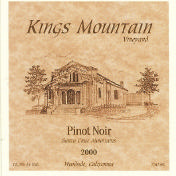 Kings Mountain Vineyard This is a small estate vineyard located in the town of Woodside. The vineyard (about 1 acre) was planted in 1992 on a private estate that has existed in Woodside since the late 1800s. The vines are dry farmed, hand-maintained and harvested. The Pinot Noirs are produced in very small lots. 1998 Kings Mountain Vineyard Santa Cruz Mountains Pinot Noir and 2003 Kings Mountain Santa Cruz Mountains Pinot Noir were both fine. I was particularly taken by the 1998, the oldest wine poured at this event, which was still vibrant with plenty of fruit, spice, and verve. Phone 650-851-7551 or e-mail alec@kingsmountainwinery.com for prices and availability. McHenry Vineyard This producer was a new find for me. I just love the style of Pinot Noir here - full of finesse and modeled after the wines of Volnay in the Cote de Beaune of France. Henry McHenry is an anthropology professor at the University of California Davis and quite a charming man whose personality is reflected in his wines. The McHenry Vineyard on Bonny Doon Road was planted in 1972 by Dean, Jane, Henry and Linda McHenry. The old vines produced numerous awards including best Pinot Noir in the state at the California State Fair. The vineyard succumbed to Pierce’s Disease in 1992, but was replanted in 1997, the last summer of senior partner Chancellor (UC Santa Cruz) Dean McHenry’s life.
2003 McHenry Estate Vineyard Santa Cruz Mountains Pinot Noir 13.5% alc., 172 cases, $19.50. This wine was aged for nearly two years in Francois Freres oak barrels and a year in bottle before release. · The winemaker, Henry McHenry said it best: “A delicate and graceful wine with a soft fruit scent. It has a velvet texture and reminds one of great Volnay in its tenderness, subtlety, and floweriness.” I just flipped over this as well as the 2004 vintage which has yet to be released. This is a perfect example of what Pinot Noir can be, but so rarely is. A lightly colored, elegant wine that is blessed with striking flavor and complexity. The price is just ridiculous considering the quality.
Luckily, I bid and won the double magnum of this wine and had Henry sign the label. Sometimes Pinot speaks to you. Www.mchenryvineyard.com. 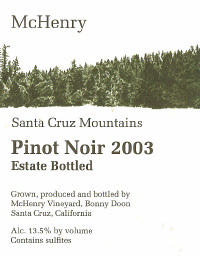 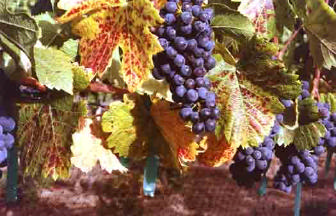 Pleasant Valley Vineyards This vineyard is in Corralitos, only five miles from the Monterey Bay. Planted in 1996, the vines are all Dijon clones tucked next to a grove of coastal redwoods. Craig and Cathy Handley are the proud owners who like to say that “the Pinot Noir has passed through their hands at several stages in the process from soil to glass.” Their wines were chosen to be poured at the recent World of Pinot Noir. There are a number of musicians in the family, reflected in the unique label. The winery website is www.pvvines.com.
2005 Pleasant Valley Vineyards Dylan David Santa Cruz Mountains Pinot Noir (barrel sample). The Dijon clones seem to thrive in the Corralitos area and this wine shows off the bright fruits that result. · There is a lot going on in this wine including smoke, spice, white pepper, and the whole spectrum of Pinot fruits.
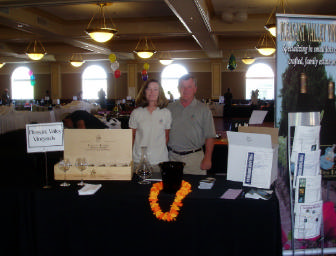 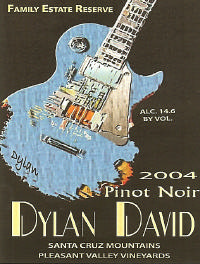 Craig has spearheaded the Corralitos Wine Trail which consists of five relatively new small wineries located in the most southern region of the Santa Cruz Mountains appellation (Alfaro Family Vineyards, Natal Vineyards, Nicholson Vineyards, Pleasant Valley Vineyards, and Windy Oaks Estate Vineyards & Winery). The wineries are open for special appellation events such as Passport Saturday on April 21 or by appointment. The close vicinity of the vineyards allows one to see all five in a day. A map of the Corralitos area is on the next page. Santa Cruz Mountain Vineyard This is one of the Santa Cruz Mountain’s oldest heritage vineyards. Ken Burnap was the co-owner of a distinguished restaurant in Orange County, California, The Hobbit, and had difficulty sourcing good Pinot Noir from California in the 1970s. He had studied Burgundy for years and set up a number of criteria for Pinot Noir vineyard success. The Santa Cruz Mountains met the criteria best and in 1974 he bought the Santa Cruz Mountain Vineyard which had been originally established in 1863 as the Jarvis Brothers Vineyard. Burnap sold his restaurant, started the winery in 1975, and devoted himself to producing distinctive mountain Pinot Noirs. The wines were rustic, acidic and tannic, and took years to mature. They were nothing like other California Pinot Noirs then or since, but his wines had character and remain an important legacy in the history of Pinot Noir in California. Jeff Emery came on board to assist Ken in 1979 and has never left. In 2004, Ken sold the property on Jarvis Road and the winemaking operations were moved with Jeff to a new location near Boulder Creek. The winery will be moving once again to the west side of Santa Cruz in 2008. Dennis Hoey has joined Jeff as an assistant. Jeff continues the tradition of wines that strongly reflect the terroir, but has improved the acid, fruit and tannin balance to make the Pinot Noirs more approachable early on. His latest releases include the 2002 Santa Cruz Mountain Vineyard Estate Pinot Noir 13.1% alc., 208 cases, $28, and the 2004 Santa Cruz Mountain Vineyard Branciforte Creek Pinot Noir. $34. 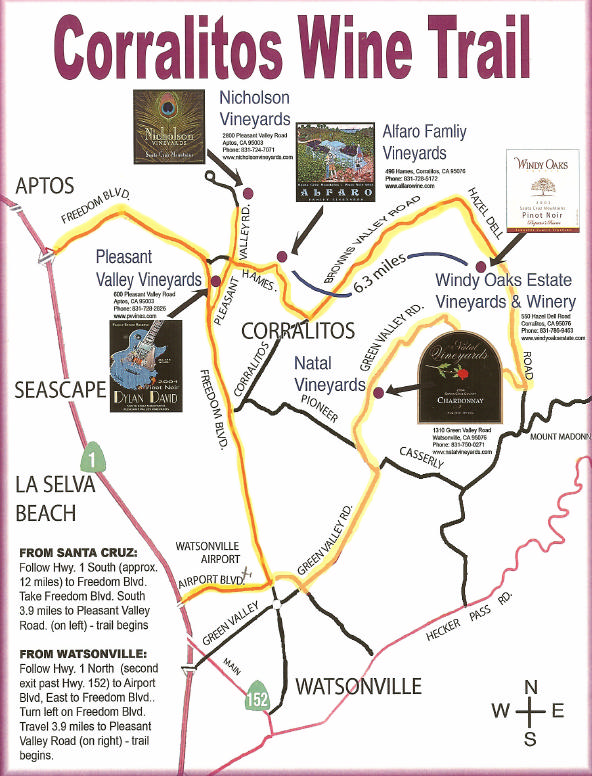 The Estate bottling comes from the original Jarvis Vineyard which is a remnant of the much larger Jarvis Brother’s Vineyard. The vineyard has been continuously operated since 1863 with two replantings. The current vines were planted in 1969 and 1970. In most years, yields are less than one ton per acre. The 2002 Estate is one sturdy, hearty and full-flavored Pinot Noir with nice earth, beef and black cherry flavors. There is some muscle for sure, but there is good balance that suggests a long life ahead. The Branciforte Creek Pinot Noir comes from grapes grown in the Corralitos area. It is like the little sister to the big brother (the Estate). Crafted in a more approachable and fruit-forward style, it has considerable charm and style. The palate is soft, long and tasty. It sports a new, modern label as well. At a dinner held prior to the Pinot Paradise event at Villa Generosa, Jeff generously poured both the 1986 Santa Cruz Mountain Vineyard Estate Pinot Noir and the 1979 Santa Cruz Mountain Vineyard Estate Pinot Noir. This was a once in a lifetime treat. The 1979 vintage was a huge wine when it was young, and when reviewed by Robert Parker, Jr. in 1983, he advised waiting until the turn of the century to even think about drinking it. It still has burly fruit and is fat in the mouth, but is thoroughly approachable and quite enjoyable now. The color was still vibrant and tasted blind, one would never guess the wine was almost 30 years old. The 1986 is drinking perfectly with attractive earthy and mushroom aromas and flavors. Since Burnap sold the estate vineyard, the last estate Pinot Noir will be 2004. Jeff and his winery dogs, Iris and Zima, are pictured below. The latest releases, as well as some older vintages, are offered on the website at www.santacruzmountainvineyard.com. Jeff also crafts a number of other interesting reds. 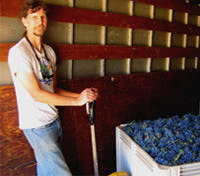
 
 Silver Mountain Vineyards I did a feature on this winery in last year’s coverage of Pinot Paradise (PinotFile, Vol 5, Issue 30). Owner Jerold O’Brien’s winery is near the top of the mountain with breathtaking views, and Jerold, along with winemaker Tony Craig, are at the top of their game. Since 2003, the Pinot Noirs have been stellar. The 2003 Silver Mountain Vineyards Miller Hill Vineyard Santa Cruz Mountains Pinot Noir ($38) was a favorite when tasted last year (“beautifully composed, balanced and sleek”), and after re-tasting it this year my impressions still hold. The 2004 Silver Mountain Vineyards Miller Hill Vineyard Santa Cruz Mountains Pinot Noir is a lighter version of the same wine with slightly less complexity and aging potential. There is still a small amount of the 2003 vintage available at www.silvermtn.com. Silver Mountain has a tasting room at the winery and on Monterey Bay. Jerold and his assistant, Mary Lindsay, are pictured at Pinot Paradise on the next page. 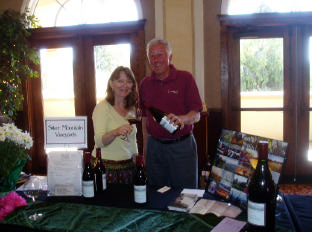 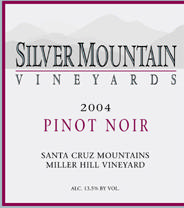 Sonnet Wine Cellars Tony Craig was also featured in last year’s PinotFile. Tony is a former Shakespearean actor whose stage is now his wine cellar. After moving to California from England and hoping to find work in Hollywood, he realized soon that he needed to pursue another career. Down to about his last $50, he answered an ad in the newspaper for a cellar worker at David Bruce. He was hired, and within 14 months, he was a part of the winemaking team. He took to winemaking naturally, and eventually became head of the vineyard-designate Pinot Noir program. As Tony jokes, “Only in America!” David Bruce Winery was a regular research center for Tony and he was allowed to try many experiments with small lots of grapes. It was through these trials that he was able to hone his winemaking style. He likes to call himself a minimalist when it comes to crafting wine, and his winemaking goals are elegance and balance, but not light-bodied Pinot Noir. After all, he remarks, “noir” means black and Pinot Noir offers density to work with. Cabernet has more pigment and is easier to work with for sure, but by guided winemaking techniques, he can stabilize the pigments that Pinot Noir does have to bring out color. The whole process begins with vineyard management. Flavors and aromas originate in the vineyard and you can’t influence those very much. So Tony focuses his winemaking on structure. He likes to age his Pinot Noirs for 14-17 months using the tightest grained oak he can find. The cooperage he uses comes from Hungary (there is tight-grained French oak but it is hard to get). The Hungarian oak has similar aroma profiles to French oak, but offers a little different spiciness and less tannin. Tony believes that lees add character so he mixes them, but does no racking. He uses a unique fermentation technique to manage the cap. Instead of punch-downs or pump-overs, he uses a pulsar system in which large bubbles of air are injected into the must from the bottom of the fermentation tank. This stirs the wine and produces a very gentle breakup of the cap, with very little resultant abuse of the grapes. The skins and seeds are not grated which minimizes the release of harsh tannins. All Sonnet wines are produced at Silver Mountain Vineyards. I paid a visit to Tony at Silver Mountain and we tasted his latest releases and some 2005 barrel samples of Tondre’s Grapefield Santa Lucia Highlands Pinot Noir from neutral, French, and Hungarian oak barrels. The differences were striking, and this was very instructive. As we sipped, I realized what a deep thinker Tony was. He brought up a good question: “All winemakers talk the same talk when asked about the uniqueness of their vineyard - coolness, fog, wind, clones (all use similar), trellising (all use VSP), leaf pulling etc. So what exactly is it that produces a sense of place in Pinot Noir? Everyone has the same answer, but really nothing insightful is being said.” If you figure that one out, let me or Tony know. Tony currently makes 1300 cases of four distinct Pinot Noirs from the Amber Ridge Vineyard in the Russian River Valley, Muns Vineyard in the Santa Cruz Mountains, Tondre’s Grapefield in the Santa Lucia Highlands, and Kruse Vineyard in York Mountain. Starting from 500 cases in 2003, he plans eventually to top out at 2,000. Tony also makes the wines under the Silver Mountain Vineyards label along with Jerold O’Brian, and under the Muns Vineyard label with Ed Muns. I tasted a number of Pinot Noirs with Tony and some brief notes are included here. Basically, Tony is looking for color, aromatics and structure and he consistently hits the mark on all three. Oak and alcohol are never intrusive. I would say seamless is a good word. I really have become a fan. The website is www.sonnetwinecellars.com where you will find all 154 sonnets from old Will. Sonnet wines are available at fine retail stores in the Santa Cruz and Bay area. Some are also sold at the Silver Mountain tasting room (408-353-2278). The phone number at Sonnett is 408-353-4520.
2005 Muns Vineyard Santa Cruz Mountains Pinot Noir This wine was only bottled a week ago, but the racking was very gentle and the wine is showing beautifully. The aromatics are striking with plenty of wood spice and spearmint.
2005 Sonnet Muns Vineyard Santa Cruz Mountains Pinot Noir 13.8% alc.. · The 2005 vintage in the Santa Cruz Mountains was on the ‘weighty’ side and this wine shows the bold structure of the vintage. Again, the aromatics are enchanting featuring bright cherries, spices, and ginger. The velvety texture alone is worth the price of admission. Perfectly balanced and thoroughly enjoyable.
2005 Sonnet Tondre’s Grapefield Santa Lucia Highlands Pinot Noir 14.5% alc.. Bottled 10 days ago. A mix of Pommard and a little 777 clone. · The nose offers the smell of fresh-crushed red grapes with a touch of chocolate. A masculine wine with more intensity than the Muns Vineyard bottling. Flavors are more earthy, like a trip in the forest. Again, the velvety texture is Pinot Noir at its best. This beauty finishes with a touch of oak, lively acid, and a hint of heat, all features that will blend and soften with aging.
2004 Silver Mountain Tondre’s Grapefield Santa Lucia Highlands Pinot Noir Similar to the Sonnet version, but with a lingering cherry and spice kiss at the end.
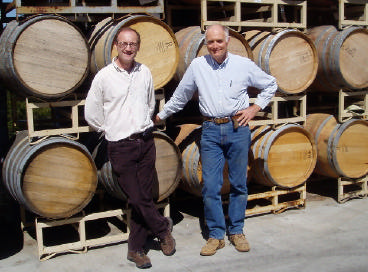 Storrs Winery & Vineyards This is a small, family owned winery that works with Pinot Noir grapes grown in the vineyards of Pleasant Valley in the Corralitos district of the Santa Cruz Mountains. A tasting room is located at Old Sash Mill, 303 Potrero Street, No.35, in downtown Santa Cruz and is open daily from 12:00 PM to 5:00 PM. Two wines were poured at Pinot Cruz and both were great. I drank this wine at home with some Springhill Farms Dry Jack. This cheese brought out the sweetness of the fruit and was a match made in heaven. The Storrs website is under construction.
2004 Storrs Santa Cruz Mountains Pinot Noir A cuvée of Christie and Saveria Vineyards · An elegant and fruity Pinot Noir that goes down easy.
2004 Storrs Wildcat Ridge Santa Cruz Mountains Pinot 14.5% alc., $40. A reserve blend of selected barrels. · The Wildcat Ridge is a more structured and complex offering. Aromas of black cherries, ripe strawberries and cola with a hint of alcohol lead to a palate loaded with wild strawberries, toast and smoke. The texture is ridiculous - rich, thick, and mouth coating. It is wines like this that make you look around and thank God you’re alive.

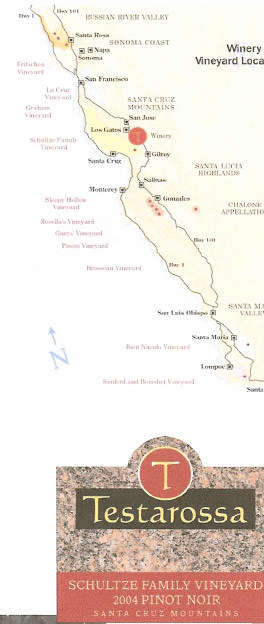 Testarossa Vineyards Rob and Diana Jensen founded Testarossa Vineyards in 1993. Today, this is among the largest wineries in the Santa Cruz Mountains, producing over 15,000 cases of Pinot Noir, Chardonnay and Syrah. The winery has a long tradition of distinguished wines sourced from vineyards throughout California (see locations on map to right), The winery is in downtown Los Gatos at the historic Novitiate Winery built in 1888. The current winemaker is Bill Brosseau. www.testarossa.com.
2004 Testarossa Vineyards Schultze Family Vineyard Santa Cruz Mountains Pinot Noir 14.2% alc., 196 cases, $54. · I think this was the most expensive wine at Pinot Cruz, but the producers need make no apologies. A very pleasant drink with red fruit flavors, a bit of Xmas spice, and a long, stylish finish. The Schultze vineyard provides the breeding and deft winemaking completes the picture.
Thomas Fogarty Winery & Vineyards I spent some enjoyable time on this trip visiting Thomas Fogerty Winery and tasting wine with winemaker Michael Martella (pictured left). Michael met Dr. Thomas Fogerty in 1980 while working at a large winemaking facility in the Central Valley of California. A friend of a friend introduced them. Fogerty had been a home winemaker for 10 years, had purchased 325 acres of land in the early 1970s, and had planted three acres of vines on Skyline Drive in Woodside. Fogerty and Martella drank some wine together, hit it off, and Martella has been there ever since. He helped Fogerty plan the winery and develop more vineyards (now 40 acres), and emotionally he feels like the winery is his! Two vineyards were planted to Pinot Noir in 1982 with
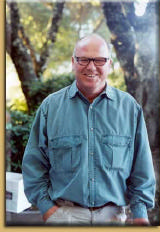 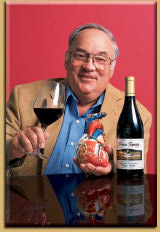 heritage selection cuttings from David Bruce, probably Martini Pommard clone. The higher vineyard, at 2000 feet, is named Langley Hill and consists of two acres, while the larger, less-elevated vineyard of four acres is called Rapley Trail. The clones planted are not the ones Martella would choose today, but he has learned to work with the ones he has and takes advantage of the vines’ extended age. Early on, Pinot Noir was sourced from the Winery Lake Vineyard in Carneros. The first vintage from the estate vineyards was in 1986. Initially the Fogerty style was full-bodied, with dark color, intense black cherry flavors, considerable structure and tannin, and were clumsy on release. I tasted the 1991 vintage (fading with sherry notes) and the 1995 vintage which was chunky when released but has now softened and has developed a pleasing bouquet and secondary flavors. Over the years the style has changed as the amount of extraction has been reduced, and better balance of fruit and tannin has been achieved. The grapes are picked riper as well. About 10-20% whole clusters are now used and the cold soak is limited to 5 to 7 days. “Rack and return” is also employed in some vintages (ie 2004, 2005) to further soften the tannins typical of the grapes from this estate. Historically, the winery has produced either a Santa Cruz Mountains Pinot Noir (with purchased fruit added to estate fruit) or an estate Pinot Noir. In special vintages, like 2003, the two vineyards were separated out, with three bottlings: Rapley Trail Vineyard, Langley Hill Vineyard, and an Estate blend of the two. Since the topography varies considerably within the Rapley Trail Vineyard, in some vintages specific blockdesignate Rapley Trail Pinot Noirs are featured as well. Beginning in 2005, Michael has sourced some Dijon clone (115, 667) grapes from the Schultze Family Vineyard in Corralitos. These grapes produce a Pinot Noir with a different and silkier texture. He likes these clones a lot and has blended them into his estate wines. In 2006, he will bottle the Dijon clones separately. Michael is planting some 115 and 667 clones on a part of his estate vineyard that was previously producing merlot. The merlot barely ripened here, but made good wine. However, merlot is a tough sale these days. I tasted some barrel samples of the Dijon clones and the bright fruitiness is quite appealing. The 2004 vintage was stellar here, but the 2005 vintage was a disaster. Michael says it was the worst harvest ever from his vineyards with mildew being the main culprit. Only 4 barrels (100 cases) of the 2005 Estate Pinot Noir were produced. What grapes he did get, made for a big, rich wine. 2006 was a beautiful year with perfect weather. The crop was big, but the wines so far lack the color and depth of 2004, so probably only a Santa Cruz Mountains Pinot Noir will be bottled. The photo shows the beautiful pond at the entrance to the winery with Langley Hill Vineyard in the distance. 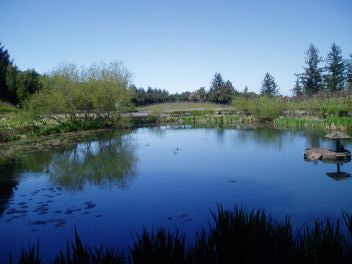
2004 Thomas Fogarty Winery & Vineyards Rapley Trail Vineyard Estate Santa Cruz Mountains Pinot Noir $50, was poured at Pinot Cruz. · This wine reminds me of the Pommard-driven West Block Pinot Noirs from Rochioli Vineyard and is my clear favorite from this winery. The fruit flavors are firm and full, long and complex, and the tannins are tame. The wine is ripe and juicy with vivid pinosity.
This is one fine Pinot. The Rapley Trail vineyard-designate was first produced in 2002 and the 2002 and 2003 vintages are still available on the website at www.fogartywinery.com. The tasting room is open from Wednesday through Sunday from 11:00 AM to 5:30 PM. The setting is breathtaking with views of the entire Silicon Valley below. The site is popular for weddings and corporate events and a separate facility has been set aside for these activities. 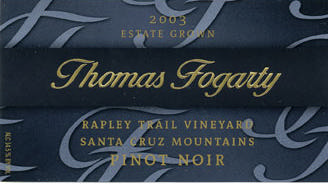 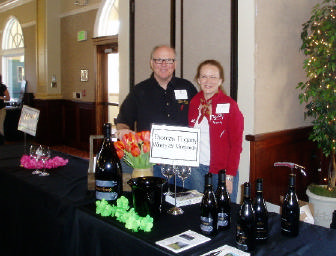 And what about Thomas Fogerty? After a successful career as a cardiovascular surgeon, innovator, and inventor, he is now on the lecture circuit. Since inventing the balloon catheter for embolectomy forty years ago, he has accumulated over 100 medical patents. He still hangs out and drinks wine with Michael. He also has a healthy passion for fishing and hunting. Michael points out that Fogerty hires good people and them turns them loose with no micromanagement. As a result Michael has been here 26 years, and likes to say, “Better to be lucky than good!” Windy Oaks Estate Vineyards & Winery Jim and Judy Schultze are escapees from the hightech world who have used their twenty years of interest and experience in artisan winemaking and winegrowing to create Windy Oaks Estate. The Burgundian varieties, Pinot Noir and Chardonnay, are produced from a 15-acre vineyard located at 1,000 feet on a ridge overlooking the Monterey Bay at the southern end of the Santa Cruz Mountains. Winemaking and viticulture here is very Burgundy themed. The vineyard is farmed according to sustainable, organic principles with all vines being hand-tended and directly monitored for water status. The growing season is long here with harvest typically in mid-October. Grapes are picked at physiologic ripeness without high Nrix and have high, balanced natural acidity. Winemaking is non-interventional. Fermentations use 50% wild yeast and last 25-30 days. No racking is done in barrel. The Schultzes travel yearly to Burgundy to meet with coopers. They use 3-year-old-air-dried tight grain French oak barrels and age their Pinot Noir for 18-25 months. The modern estate winery is all gravity-driven. Windy Oaks also supplies grapes to other Santa Cruz Mountain producers, and plans are afoot to expand their vineyard holdings. I tasted two Pinot Noirs at the event and they were both superb. Windy Oaks is quietly becoming a cult wine in the Santa Cruz Mountains.T here is a lot of magic in the air in Corralitos. The wines are sold through a mailing list and from the website at www.windyoaksestate.com. Winery visits are available only by appointment or on special Santa Cruz Mountains appellation events. The phone is 831-786-9463. One other note, readers probably think I only drink Pinot Noir. Surprise! I also enjoy fine Chardonnay. A man needs a white wine too.
2004 Windy Oaks Estate Proprietor’s Reserve Santa Cruz Mountains Pinot Noir 175 cases, $45. · The Reserve is the winery’s signature wine. This one will stand up to anything produced in California and is everything you could hope for in a Pinot Noir. From classic Pinot aromatics of Bing cherry and spice, through elegant, sweet and vivid fruit with a caressing texture, to a lasting finale, this is one impressive drink. You won’t be able to get enough of this one.
2005 Windy Oaks Estate Diane’s Block Klein Family Vineyard Santa Cruz Mountains Pinot Noir 153 cases, $40. The Diane’s Block is the second vintage from this 4-acre vineyard in Aptos. · It has its own charm and distinctive character with racy mixed berry and black cherry fruit, a soft texture, ample acidity, and supple tannins. There is a lot of magic in the air in Corralitos.
2004 Windy Oaks Estate One Acre Santa Cruz Mountains Chardonnay 94 cases, $30. · A stunner. This is a Kistler-killer for half the price! Perfect balance with butter, caramel, and exotic fruit notes, and demure acidity.
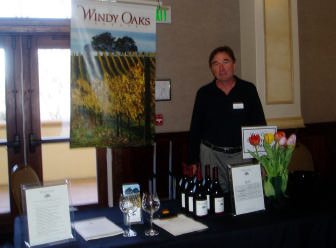 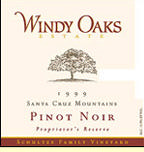
Muns VineyardEd Muns represents an example of the current heart and soul of vineyard development in the Santa Cruz Mountains. Ed is a former executive with Hewlett-Packard, who along with high-tech publicist, Mary Lindsay, planted 13 acres of Pinot Noir in 1998 on a ridge at 2,620 feet, making it one of the highest vineyards in the Santa Cruz Mountain appellation. Initially, Bill Murphy (Clos Le Chance, CK Vines) assisted with the planting and management, but Ed is on his own now. Several years ago Ed was searching for property in the Santa Cruz Mountains and the one he finally chose was not love at first site. There was a home on the property, but the remnants of a vineyard were completely overgrown with brush, bushes and trees. Ed never really intended to grow grapes upon retirement, but the vineyard sparked his interest. It took more than two years of work to clear the property for planting. Dijon clones 114, 115, 667 and 777 thrive here with cooling breezes, and cool nights all year long. Because of the altitude, fog is rare. There is also a smattering of heritage clones planted. The obstacles for successful growing of grapes here are multiple. Frost is always a threat and there is essentially no way to combat it. Gophers thrive here and require a crew to constantly trap them. Ed’s dog, “Pinot,” takes out several a day when he puts his mind to it. Deer love Ed’s vines and if they find a break in the fencing, they can consume a 1/2 acre of new growth in an evening. Of course, birds are rampant in the nearby trees and brush, and netting of the vineyard is absolutely necessary. It is no wonder, that a number of Silicon Valley dreamers left the tech world to start their own vineyard in these mountains, but left sheepishly within a couple of years. Ed says, “It sounds romantic, but it is a lot of thankless work. There is constantly something to do like maintenance, spraying for mildew, clearing new weeds and growth, pruning, training, and on and on.” In the 1970s, this land was used for a Christmas tree farm, so trees keep popping up in the vineyard! Ed’s first harvest was in 2003 and his original intent was to sell the grapes to locals like Soquel Vineyards, Sonnet and Silver Mountain. He soon discovered that he couldn’t break even just selling grapes, so in 2003 he started his own label, Muns Vineyard. The initial vintage was made by Soquel, but the wines are now made at Silver Mountain by Tony Craig (see page 16). I visited and walked Ed’s vineyard and I found it to be one of the more pristine vineyards in the Santa Cruz Mountains. No question in my mind that this vineyard will be producing some remarkable Pinot Noirs for many years to come. Www.munsvineyard.com. 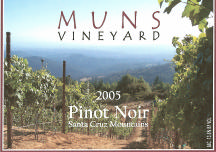 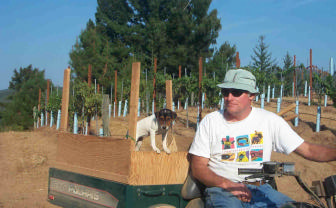 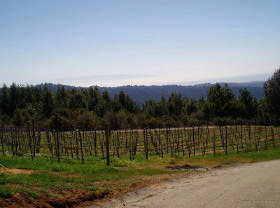
Loma Prieta Winery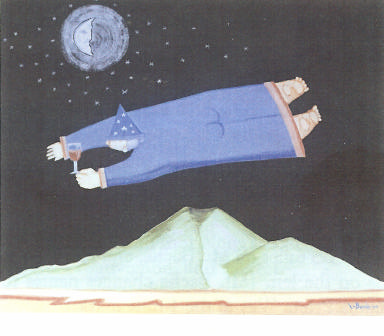 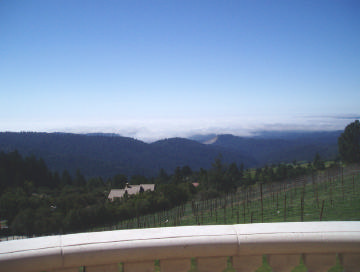
Being energetic and resourceful, Paul decided to produce his own wine in 2003 from purchased grapes. He used a consulting winemaker for guidance and essentially made the wine in his garage. He was startled when two wines were awarded gold medals: the 2003 Loma Prieta Cabernet Sauvignon won gold at the 2006 West Coast Wine Competition, and his 2004 Loma Prieta Pinot Noir won gold at the 2006 San Francisco Bay Wine Competition. He was flattered, but his intent is not to win medals, but to make wine he can be proud of, enjoy drinking himself, and sell a to other wine lovers. With planned production of 500 cases of Pinot Noir, he knows he will probably not make any money at it in the foreseeable future. Paul and Amy are shown below with their son and long-time friend. 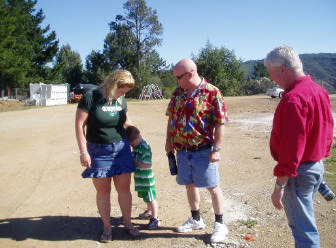
2005 Loma Prieta Winery Santa Cruz Mountains Pinot Noir 13.5% alc., $50. · There are plenty of attractive red fruit aromas in this wine with a nice touch of oak vanillin. Flavors of fresh cherries, earth and anise are set off by attractive oak notes in the background. The texture is quite gentle and softer than the 2004.
2004 Loma Prieta Santa Cruz Mountains Pinot Noir 13.5% alc., 44 cases, $50. The grapes come from the Corralitos area of the Santa Cruz Mountains. · This is a big-styled wine in the sense of prodigious fruit, but it has a silky texture and soft mouth feel. The attractive aromatics feature black cherry, wet leaves, toast, and a hint of Jolly Rancher red candy. Flavors tend toward the earthy side with mushroom prominent. Plenty of ripe dark fruit coats the palate. The finish is a little warm, but there are nice oak and bittersweet chocolate memories.
There is some limited distribution of the wines in the Santa Cruz area. You can contact Amy, who handles the sales and marketing at 408-353-4570. She is a real wine enthusiast and knows Pinot. The wines are also sold through the winery website at www.lomaprietawinery.com. Winery visits are available by appointment, but don’t head up there without strict instructions from Amy as maps and navigation systems are incorrect! The address is 26985 Loma Prieta Way, Los Gatos, but this estate is about as far away from the town of Los Gatos as you can get. It is an adventure driving there, but once you arrive, you will receive a warm welcome and a glass of Pinot as you succumb to the magical view.
Clos De La TechClos de la Tech is a name derived from the Burgundian word for vineyard or “clos” which means enclosed area, or more specifically, refers to the rocks that were removed from the land to form a stone wall around the vineyard. The "tech" part of the name is a reference to the owner’s tech background and the silicon chips on the neck of every Clos de la Tech bottle. In 2002, the latest release, two real silicon memory chips with 1.02 billion transistors on them are on each bottle (at $0.0000001 per transistor, that’s $102 in value, making the wine free!). 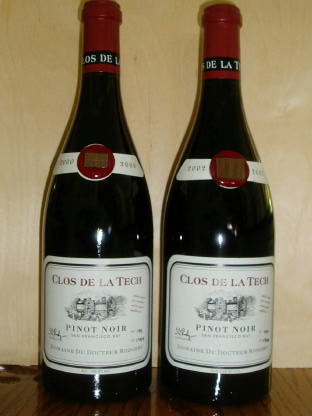 Rodgers has three vineyards planted in the Santa Cruz Mountains region - Domaine Docteur Rodgers, Domaine Valeta, and Domaine Lois Louise. Domaine Docteur Rodgers is a one-acre vineyard adjacent to Rodgers’ home in Woodside planted to Dijon clones 113, 115 and 777. Close-spacing of vines and small yields are the norm here. The first Clos de la Tech wines were sourced from this vineyard beginning in 1996. The Domaine Valeta vineyard is 3 1/2 planted acres on a 30-acre site perched on a peak at 2,300 feet looking down on Silicon Valley. This is a colder site, producing wines that are more tannic and aromatic than those from Rodgers. The first wine made from this vineyard is the 2002 vintage, to be released in 2007. Domaine Lois Louise, named after Rodger’s mother, is a 25-acre ridge-top vineyard within a 160-acre parcel in the hills above La Honda. This is probably the steepest vineyard in California. The first wine produced from this vineyard was the 2004 vintage. Eventually, 80 acres will be planted here and the wine will be made inside three 300 ft. caves blasted out from the hillside. 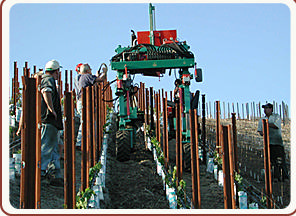 Vineyard manager Rex Geitner, who has managed vineyards at Stag’s Leap Wine Cellars, Domaine Carneros, and Robert Keenan Winery, oversees the vineyards. The rows are very tightly spaced at Domaine Lois Louise, and vine spacing is minimal, with about 4,000 vines per acre. Because of the cooling effects and exposure to the Pacific Ocean, disease pressure is high and the project will not be totally organic. Farming here is definitely high-tech, but winemaking is very traditional in the Burgundian mold. Rodgers employs whole-cluster fermentation, sur lie aging, and foot-crushing. Careful scientific monitoring is employed, however, and winemaking decisions are made both on taste and chemical measurements. The new winery facility at Domaine Lois Louise will utilize gravity flow and plans are to install 56 fermentors to allow simultaneous fermentation of multiple eight-barrel lots of wine. A special press was designed by Rodgers that can be moved to the tank and must without separating the press and free run juice. The result is that he can use both in making the final wine.
2002 Clos de la Tech Domaine Docteur Rodgers San Francisco Bay Pinot Noir 13% alc., 101 cases, $101.50. · The exotic nose features cherries and rare woods with a touch of heat. The mouth feel is fuller than the 2000 vintage and there is more fruit with spiced cherry, plum and chocolate flavors. The finish is tart, but has more acceptable acidity.
2000 Clos de la Tech Domaine Docteur Rodgers San Francisco Bay Pinot Noir 13% alc., $101.50 · Light in body, this delicate Pinot Noir has aromas of super ripe fruit tending toward prune with a touch of herbs. The flavors of tart cherry end in a finish with searing acidity.
I cannot relate well to these wines other than to compare them with some older Burgundies I have had. They will have limited appeal to those fans of the plush style of California Pinot Noir. It will be interesting to monitor the future wines as the two newest vineyards come online. With the passion and resources (Rodgers has spent more than $20 million since breaking ground at Domaine Lois Louise in 2001) that Rodgers has at his disposal, his future success is likely. Although Rodgers and Massey have no formal training in enology or viticulture, it is a given that the science of winemaking can be learned and gifted people often find success as vintners. This is a fascinating and innovative project to keep your tabs on. Up to now, the Clos de la Tech wines have been sold to a small group of Rodger’s friends and a tiny mailing list. As more wine becomes available, the options for purchasing will increase. Visit the website at www.closdelatech.com for more information.
Traveling in Santa Cruz MountainsIf you plan to travel and visit some of the wineries in the Santa Cruz Mountains, some sage advice is offered. Leave your nice clothes at home. The maps of the area often show the roads as straight lines - be forewarned - the roads are one or two narrow lanes and zig-zag like crazy. If you think you can drive from point A to point B in 30 minutes, allow one hour. Turn off your navigation system, it will not be accurate. Signage to wineries is almost nonexistent (the locals won’t allow it and often remove any signage that is posted). A four-wheel drive vehicle is always a good idea. Only plan on visiting two wineries, maybe three, a day as you will inevitably be delayed on the road, miss a turn, or become hopelessly lost. And remember, your cell phone will probably be of no value. Despite the challenges, you will find your excursion a memorable escapade that will be well rewarded by a warm welcome upon your arrival. Chill out, smile, and enjoy the vistas. This is one of the few remaining wine country outposts where you will never see a limousine and the tasting room staff will actually be happy to see you. It is an adventure well-taken.
Visiting Santa Cruz MountainsFor assistance in planning winery visits, maps, and a listing of the wineries in the Santa Cruz Mountains as well as a schedule of special events in the appellation, consult the Santa Cruz Mountains Winegrowers Association website at www.scmwa.com or call 831-685-8463. To purchase Santa Cruz Mountains wine, contact the winery websites. There is a Santa Cruz Wine Club called Pinot Only! at www.santacruzwineclub.com. Four bottles of Pinot Noir from a variety of Santa Cruz Mountains Vintners are delivered to you twice a year (each shipment approximately $100 plus shipping and tax). There is a wine store in downtown Santa Cruz, vinocruz, which specializes in the wines of the Santa Cruz Mountains. They stock 150 wines from 60 wineries within the Santa Cruz Mountains including wines from several prominent wineries I did not discuss in this issue such as Cinnabar, Mount Eden, Salamandre, Savannah Chanelle, Soquel Vineyards, and Varner. Vinocruz has a tasting room as well. The website is www.vinocruz.com. For very personalized trip planning and winery appointments, contact Laura Ness at www.higherf@got.net. She is a resident of the area and is a representative of the Santa Cruz Mountains appellation. She can advise you on places to stay, restaurants, and things to do in the region as well. You can read her features on the region at AppellationAmerica.com.
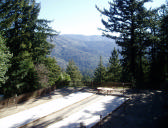 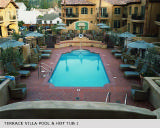 On my recent trip to the Santa Cruz Mountains I stayed at two different options for travelers to the area. The Villa Generosa (left) is a large, three bedroom home with gourmet kitchen, outdoor Jacuzzi, bocce ball, and gorgeous views located on Summit Road close to several wineries (www.villagenerosa.com). The Hotel Los Gatos is a very classy Spanish-style lodging in downtown Los Gatos within walking distance of many shops and restaurants (www.hotellosgatos.com). Both are highly recommended and both can now say “The Prince slept here.” |